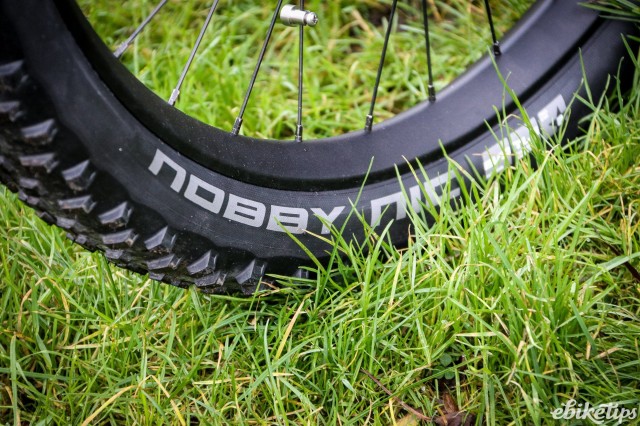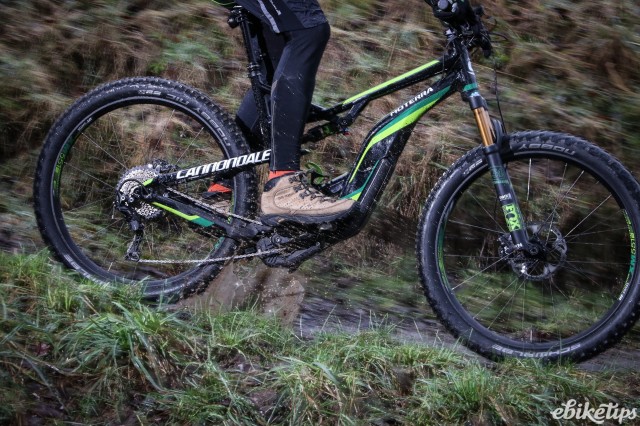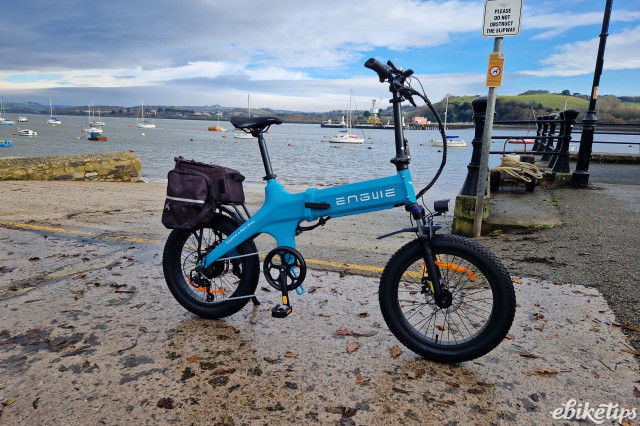So I'm hurling myself off a gnarly drop off. Okay, so it's not a very big drop-off. And it's not really gnarly, and I'm not exactly hurling, more tiptoeing. But I am riding off it, somewhere near the edge of my mountain-biking comfort zone. And it's all for you, dear reader, so we can know more. Specifically, about whether shorter suspension and big, plus-sized tyres is better. Or is it preferable to have more travel and standard tyres on your e-MTB? Read on, and find out. Or if you can't be bothered: well, it depends. So I hope that's cleared that up.
The Plus effect
No doubt about it, plus-sized tyres have made a big splash in the e-MTB market. Two years ago you'd have struggled to find a bike with 27.5+ tyres, now they're everywhere. Plus bikes use a wider rim (typically 35-40mm) and a bigger tyre. There's a sliding scale of bigness, of course, but Plus really starts at about 2.6” and runs through to 3”, beyond which you're moving into proper fat bike territory. The wheels are generally wider, too, using the Boost standard that Trek developed and most other manufacturers have adopted: 110mm at the front, 148mm at the rear. It's a bit confusing having rim and wheel widths in millimetres and wheel diameter and trye sizes in inches, but there we are. Anyway, why have they become so popular?
One of the main reasons is traction. Especially if you're running them tubeless, the bigger tyres can be run softer, giving you a much bigger contact patch. When you've got a powerful mid motor at your disposal as well as your legs, extra traction is a real plus point. If you're on a hardtail then the tyres offer a softer ride than standard tyres and soak up the hits a bit better, which is also a bonus on a heavier electric bike. They're not a substitute for proper suspension, and they're generally a lighter construction with thin sidewalls, so they can feel a bit more vague when you're riding hard. The extra weight of the tyres over standard rubber is a negative on a non-powered bike, but on an e-MTB it's not really an issue. Anyway, there are ups and downs: the best way to discern the differences in the real world is to do some ups and downs of our own.
Making this side-by-side comparison possible are Cannondale, who've just launched the Moterra e-MTB in the UK and we've got our hands on some of the first production bikes. The Cannondale Moterra 1 you may have already seen on the site: it's a 130mm all-mountain design with 27.5+ wheels and tyres. But there's also a similarly-specced, similarly priced longer teavel version of the bike – the 160mm Moterra LT 1 – and we've managed to get our hands on one of those as well.
About the bikes
The Cannondale Moterras share some features, so let's look at them first. Most obvious and quite high in the marketing blurb is the torsion box down tube, which places the battery underneath the frame rather than sticking it on top. Why do that? Well, the battery is heavy, and moving it down lowers the centre of gravity which, Cannondale say, gives better handling. The battery is protected by a rubber cover (the BatStrap) and the motor has an alloy skid plate to keep it out of harm's way.
Cannondale use their own motor mount because they wanted a pivot point unaffected by torque from the motor or the pedals. They also wanted to keep the chainstays as short as possible, and to that they've introduced their Ai offset chainline too. Moving the chainline out 6mm gives space for the pivot, and also improves mud clearance around the rear tyre. Cannondale use an extra-wide 157mm rear hub to keep the rear suspension as laterally stiff as possible.
The frames look very similar but it's not just a case of bolting a longer travel fork and shock on the LT bike: they're two different frames with different geometries. The Moterra 1 has a 67.5° head tube with the LT bike slacker at 66°; the LT bike is also slightly shorter, with the bottom bracket a bit higher. They're small differences but they add up; the LT is designed for faster riding and bigger hits, with the 130mm Moterra more of an all-rounder.
Both bikes use 27.5” wheels. The Moterra 1 has 40mm DT rims and Schwalbe Nobby Nic SnakeSkin 2,8" tubeless ready tyres. The LT version has 30mm rims and Schwalbe Magic Mary SuperG (front) and Hans Dampf SuperG (rear) 2,35" rubber. The LT's tyres are much more gravity-oriented, with stiff sidewalls.
Much of the £500-ish difference in the price of the two bikes comes down to the fork: The LT's FOX Factory 36 Kashima Coat fork is a top-dollar choice giving 160mm of super-smooth travel. The Moterra 1 gets a Fox Factory 34 fork with 130mm travel, still a high-end unit befitting the high price tag. Both bikes get 3-position FOX Factory Float EVOL rear shocks, with 130mm and 160mm of travel respectively. And both bikes use the same Shimano XT transmission and brakes, and KS dropper 'post. So with a day at Bike Park Wales blocked out and no need for an uplift, and some back-to-back testing on the trails. Let's head out!
Climbing
Before you can do any descending at Bike Park Wales you have to drag yourself to the top, 275m above the centre. You can book an uplift for this, or climb on the fire road. Or you can use the uphill trail, the Beast of Burden. On a standard all-mountain bike this is a pretty serious undertaking, and on a longer travel bike it stops being fun fairly early on.
The first thing you learn about electric mountain bikes is invariably this: climbs are fun. Not just manageable, or quicker, but actual fun. Climbing on an e-MTB is all grins, really. When the uplift people ask if it's cheating, we reply: cheating at what? Having fun? Would you rather sit in a bus, or be able to enjoy the climb and ride twice as far?
The Beast of Burden could have been specifically made to highlight just how much fun climbing on an e-MTB is. Swoopy and graceful curves with the odd steep rocky scramble and tight haripin section, it's great for honing your skills. And because you're not on the ragged limit, you can do exactly that.
And which of the bikes is best on the climb? For me, the 130mm Moterra 1 gets the gong here. It's a super-assured ascender with the big tyres offering exceptional grip over loose rocks and roots, and there's ample suspension travel for anything you'll encounter when climbing. The 3-position shock isn't really necessary for the most part on an e-bike: keep it plush, stay seated and enjoy the ride. The Moterra LT wasn't any slower, but it did feel like more work: you need to be a bit more careful when things get slippy not to lose the traction at the rear, and a bit more precise when you're pointing it at a turn. It's by no means a bad climber though, and it's an absolute revelation compared to doing the same on a non-powered 160mm bike.
Descending
Once you get to the top, the only way is down. I'm more of a blue-and-red kind of a rider than hanging on through the black runs, and there's lots of variation in the trails from huge swooping berms to tight, rocky switchbacks and jumpy sections.
The unique pivot position on the Cannondales and the relatively short chainstays make the bikes more manageable in very twisty sections such as the rocky switchbacks on Bonneyville; the difference in the head angles between the two bikes wasn't especially noticeable there, but it was heading off the multiple drop-offs on Insufficient Funds. That was the point at which I suddenly became a lot more at home on the longer-travel bike with its extra travel and stiffer, more predictable tyres. It's not like you can't ride the drop-offs on the shorter travel bike – I've done them on the Orbea Wild hardtail – but the LT is less bouncy and squirmy on the landing making it easier to link stuff together. The same is true to a lesser extent of the bermed sections: you tend to get a more predictable line out of the LT making it a little bit easier to hold your speed. If you're riding sufficiently fast for that to be the difference between hitting the next berm and hitting a tree then Plus tyres probably aren't for you. I don't tend to be riding right at my limit (kids, day job, etc) and the trade-off on the descents is pretty small.
The bottom line is that both of these bikes are really capable heading back down the hill. The battery positioning and Ai chainline aren't a gimmick: the lower centre of gravity and short chainstays make them feel like proper trail bikes. There's very little compromise at all. You do feel the extra weight every now and then, but these are both a really involving ride on the downs.
Conclusions
And which is best? There's no right answer here: it's a horses for courses kind of a thing. The first thing to say is that both the Moterra 1 and the Moterra 1 LT are cracking e-MTBs, they really are. The way that Cannondale have mounted the battery and motor is innovative and the lower centre of gravity is noticeable when you start hitting the more technical stuff. The extra weight of the bike is contained in the sprung mass and that makes both bikes feel very planted on the trail, with the suspension at both ends staying supple through the whole range of travel. Plus, the bikes look chunky and aggressive, and the Bosch Performance Line CX motor is still the one to beat off-road. I like both of these bikes. A lot.
The trade-off for lowering the centre of gravity by slinging the battery underneath is that it's in a more vulnerable position. Okay, the bat-strap does a good job of keeping the battery safe from stones and mud thrown up fron the wheel but if you ground this bike on the down tube by accident, you're grounding it on the battery. If the riding you do makes that a possibility/likelihood then you'll need to weigh up the pros and cons. For me, it's unlikely I'll come up short on a big jump, because I'm not likely to be doing one in the first place. So I'll take the better handling.
Overall, my favourite of the two bikes was the Moterra 1. Given that I'm more likely to keep my tyres on the ground than take any opportunity to unstick them, it suited my style of riding better: the increase in traction on the climbs is stark over the harder tryes of the LT bike, and I didn't feel like I was wanting for travel on the downs. I did have a few moments where the big tyres were a bit squishy and bounced me off line, and at other times they scrabbled a bit when turning hard, but overall the extra cushioning and grip more than make up for that over the course of a day. If you were just riding Bike Park Wales the whole time you'd probably want to trade up to the LT. There's certainly a point past which it's a more predictable and capable bike. On the drop-offs of Insufficient Funds it was much easier to spot a landing on harder tyres, bigger forks and a slacker frame, and as you move from red lines to black you'll certainly find the LT the better choice. That's the exception for me, rather than the rule. Your mileage may vary.
There's an argument that since the weight of the bike is less of a concern, you may as well go with all the travel you can. All other things being equal, that's probably true: if the Plus-tyred Moterra 1 was a 160mm frame too it wouldn't really be compromised by it. Having said that, there isn't really anything I'd do day-to-day for which 130mm isn't enough. I did ride the Moterra last year in Austria on a long and difficult red trail where I'd have welcomed the extra travel. I did have a broken shoulder though, so it's maybe not a fair comparison. I didn't know it was broken, by the way.
I love going to Bike Park Wales but I've also been riding the Moterras on the local trails around Bath, and for mixed riding with road sections and less technical terrain the shorter-travel, fatter-tyred bike feels more suitable. The extra traction, combined with the motor, means you can ride trails year round that normally aren't any kind of fun at all in the winter, extending your options. Plus you can just ride further for less effort, meaning it's easier to fit a quick ride in. The mud at Bike Park Wales doesn't tend to clog bikes up but the mud around Bath certainly does, and the short travel Moterra 1 has seen some muddy miles with no issues with the drivetrain. Some e-bikes deal much better with the mud than others and the Cannondale is up there with the good ones.
Full reviews of both these bikes will be on ebiketips soon, but it's a thumbs-up from us. Which one suits you best will depend on what you're going to do with it, but they both come highly recommended. Look out for the reviews soon.

















